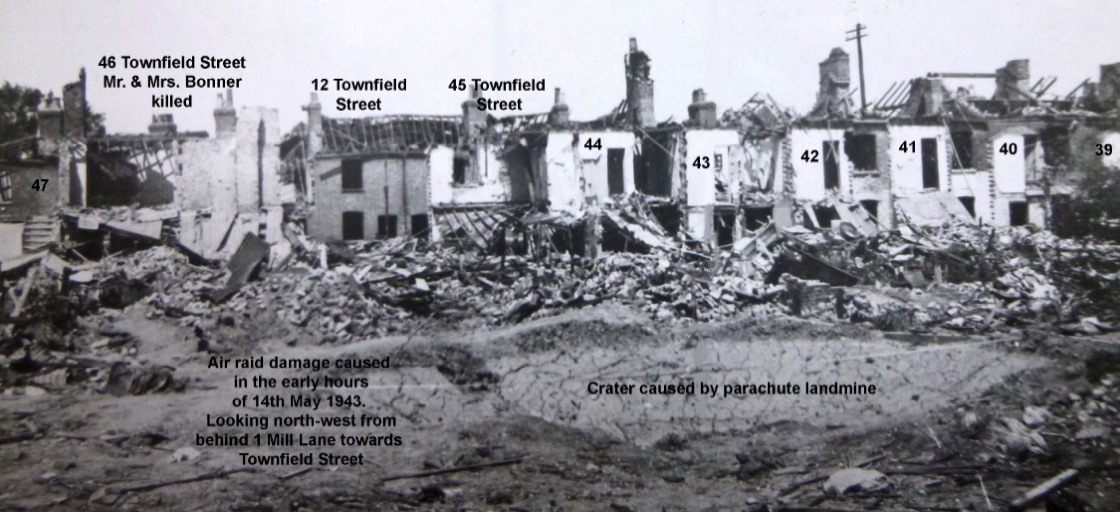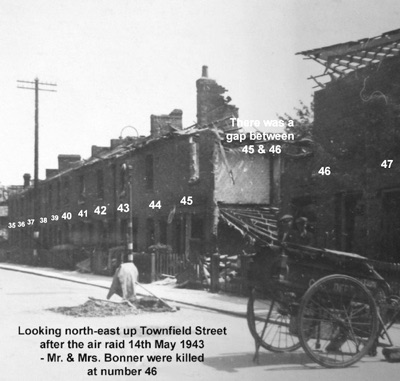George Edward BONNER, Civilian
Killed in air raid at 46 Townfield Street, Chelmsford. Aged 65


acid." — Supt. Brown now applied for the summons to be withdrawn saying defendant's wife and friends had offered to look after him. In the circumstances he (the Superintendent) did not propose to offer any evidence. - Defendant expressed his great regret, and said it had been done on the spur of the rnoment and by word of honour, it would not happen any more.—The Mayor said they were all very sorry to see defendant in that position. He was a man good character, and was well known to them. They would allow the summons to withdrawn, and defendant would leave the Court with their best wishes. —Defendant: Thank you, sir. It will not happen again.—Mrs. Bonner, wife, also thanked the Bench and the police for their kindness to her husband. Defendant then left the court with his wife and friends."
George’s father died in 1933.
By 1943 George and his wife were living at 46 Townfield Street in Chelmsford, with George still working as a decorator,
In the early hours of 14th May 1943 Chelmsford experienced what was to prove to be its heaviest air raid of the war. In a sharp attack that lasted for just over an hour, the German air force, the Luftwaffe, dropped a large number of high explosive, incendiaries and parachute landmines which caused extensive damage to residential, commercial and industrial properties in the town, and led to the deaths of more than 50 people. Locally it became known as the 'Chelmsford Blitz'.
During the raid a pair of parachute landmines, apparently intended for Marconi’s factory, narrowly missed the factory and struck residential areas. One fell to the north-west of the factory and scored a direct hit on 8 Victoria Crescent. The other parachute landmine fell a couple of hundred yards south, in between Townfield Street, Chapel Place, Mill Lane and Railway Street. It detonated directly behind 46 & 47 Townfield Street and 1 & 2 Mill Road, leaving a water-filled crater 35 feet across. The explosion caused a considerable amount of damage to nearby buildings in the four surrounding streets, but inflicted two fatalities, George and his wife, who were killed at their terraced home, 46 Townfield Street.

George Edward Bonner was boen and brought up largely in Springfield. He became a member of the 2nd Essex Volunteers and in 1900 went to South Africa to fight in the Boer War. He was invalided home after seeing action. He then worked as a house painter and in 1911, when aged 33 he married. He then lived in Glebe Road and by 1915 was living in Townfield Street which was his home until his death. He served in the army during the First World War and was wounded. Later he worked at Hoffmann's bearings factory. He and his wife were killed in May 1943 during the 'Chelmsford Blitz' when their home was destroyed by a German parachute landmine.
George was born in Springfield in 1878 one of two children of of George Lewis Bonner and Annie Eliza Bonner (nee Bloomfield). His parents had married the previous year. George and his sister, Hetty (born in 18) were baptised at St. John's Church, Moulsham on 24th January 1883. At the time his father was a labourer of Moulsham Street, Chelmsford.
In 1881 George was listed by the census living with his parents, step-brother, grandmother, aunt and uncle at The Wharf in Springfield. At the time his father was a bricklayer.
A decade later the census recorded 13 year-old George living with his parents and sister in Coppin's Yard off Springfield Road, Springfield. He was a scholar and his father was a labourer.
In January 1900 George, a member of the 2nd Essex Volunteers, signed up to join the City of London Imperial Volunteer Corps - usually referred to as the City Imperial Volunteers (C.I.V.s) - to fight in the Anglo-Boer War in South Africa. There he took part in fighting but caught rheumatic fever and was invalided home. A Chelmsford newspaper reported:
"RETURN OF A CHELMSFORD C.I.V.
Private George E. Bonner, who left Chelmsford with the other Volunteers who helped to form the C.l.V.s has been invalided home after an attack of rheumatic fever. He took part in several engagements, the principal of which was that of Diamond Hill, which lasted for two days, in which battle the C.l.V.'s lost two men killed, and several wounded.
Private Bonner was taken ill with rheumatic fever at Heilbroc, and was in the hospital there for three weeks. During that time the British troops retired from the place, leaving each man with ten days' provisions. The Boers then captured the town, but the sick and wounded were treated well by the Boers, and Bonner saya he had all he wished for. He had no fault whatever to find with the hospital arrangements. Although the hardships were severe in camp. All the Chelmsford Volunteers were well when he left."
The 1901 census found 22 George living with his parents and other relatives in Springfield Road, Springfield. George was a house painter,
In 1911 the census recorded 33 year-old George, unmarried, working as a house painter and living with his father and a boarder at 15 Springfield Road, Chelmsford (subsequently renumbered). At the time his father was a general labourer.
Later that year, on 24th September, George married Agnes Ginn at St. John’s Church, Moulsham. At the time George was 34 years old, employed as a painter, and still lived at 15 Springfield Road. Agnes was 37 years old, and lived at Roper’s Square off Moulsham Street, Chelmsford.
In 1913 George and his wife were living at 24 Glebe Road in Chelmsford. By the autumn of 1914 they had moved to 46 Townfield Street, Chelmsford, which was their home for the rest of their lives.
George served in the army in the First World War and was wounded. Later he worked at Chelmsford's Hoffmann's bearings factory as a viewer.
In December 1929 George appeared before Chelmsford's magistrates. One of the town's newspapers reported:
"CHELMSFORD MAN CHARGED WITH ATTEMPTING SUICIDE
At a special Court at Chelmsford on Friday afternoon, before Alderman Spalding, George Edward Bonner a viewer, of Townfield Street, Chelmsford, was charged with attempting to commit suicide.
P.s. Feakes said that at 8.40 that morning defendant called at ihe Police Station with regard to another matter. Witness cautioned him and he said "I have taken poison, but did not take enough; I took nitric acid." There were no outward signs that defendant had taken poison, but he complained of a burning sensation in his stomach. Witness gave him some carbonate of soda and milk, and sent for a doctor. When charged with attempting commit suicide defendant replied, "I have nothing to say."
Det.-Sgt, Shelley said that at 10 am that day he visited the works of the Hoffmann Manufacturing Company, and in the final viewing department he found the three bottles produced, one marked poison and another nitric acid. Later as witness was taking one of the botties out of some paper, defendant exclaimed "That is the one I had it from."
Defendant was remanded ih custody until to-day (Friday)."
The next day another newspaper reported:
"Withdrawn.—George Edward Bonner, a viewer, of Townfield Street, Chelmsford, was charged on remand with attempting to commit suicide.—At the previous hearing P.s. Feakes said defendant
called at the police station, and stated, " I have taken poison, but did not take enough; I took nitric;
The property was demolished by the blast along with its immediate neighbours, numbers 45 & 47. The remaining 11 houses on the south-eastern side of the road, numbers 35, 36, 37, 38, 39, 40. 41, 42, 43, 44 & 45 were all damaged beyond repair. Opposite them, all 25 properties in the terrace from number 1 The Royal Steamer P.H. to number 25 The White Horse P.H. were seriously damaged. Beyond Glebe Road the remaining nine houses, numbers 26 to 34 Townfield Street were damaged to a similar degree. The whole block formed by Townfield Street, Chapel Place, Mill Road and Railway
Street was subsequently purchased after the war by the Council for use as a car park.
George and his wife Agnes were both buried at Chelmsford Borough Cemetery in an unmarked grave (number 5441) on 21st May 1943. Their service was conducted by the Reverend T. H. Cullen.
A Chelmsford newspaper reported that the Bonners had been described as 'two of the nicest people you could meet.'
150222